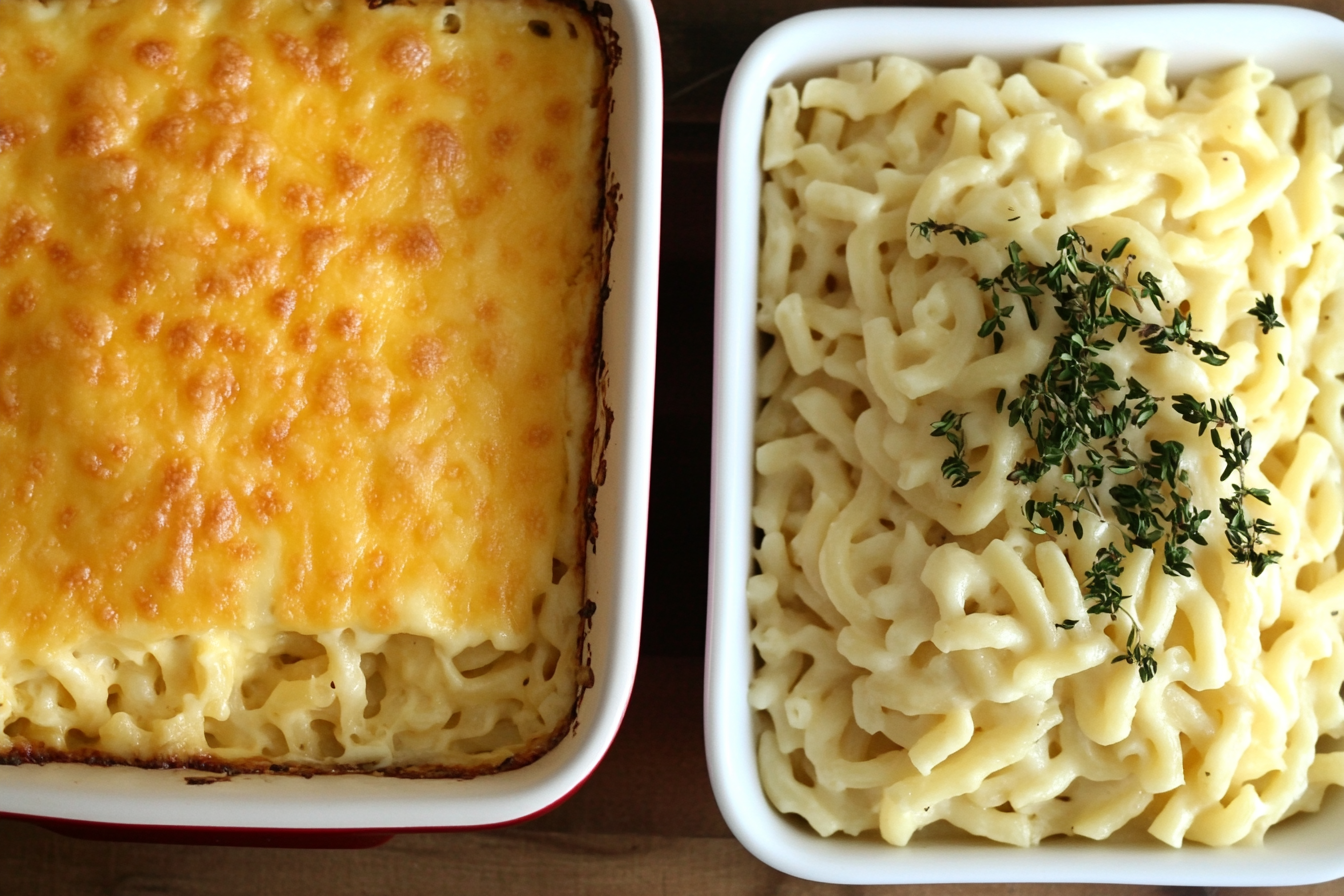When exploring classic comfort foods, mac and cheese often tops the list. However, some may wonder, what is the difference between mac and cheese and macaroni and cheese? While the terms are often used interchangeably, subtle differences may exist in preparation, context, or even regional interpretations. In this article, we’ll dive into the fascinating histories, definitions, and culinary aspects of both, offering a thorough comparison that satisfies both curiosity and appetite.
History of Mac and Cheese
The origins of mac and cheese can be traced back centuries. It is widely believed that the dish was inspired by pasta and cheese recipes from medieval Europe. Early versions often combined simple pasta with melted cheese, creating a rich and satisfying dish for those who could afford it.
- Thomas Jefferson introduced a variation of this dish to America in the late 18th century after tasting it in France.
- By the 19th century, mac and cheese became popularized in American households, especially after boxed versions became available.
This dish has since evolved, yet its simplicity and comfort remain unchanged, making it a staple in many kitchens.
History of Macaroni and Cheese
Although similar to mac and cheese, the term “macaroni and cheese” often carries a more formal connotation. The dish’s history is deeply rooted in Italian cuisine, particularly the use of maccheroni pasta.
- The first recorded recipe dates back to 1770 in Elizabeth Raffald’s cookbook, “The Experienced English Housekeeper.”
- Unlike the modern boxed versions of mac and cheese, early recipes called for freshly made pasta and cheese sauces.
As the dish spread globally, its name transitioned based on cultural and linguistic differences. To this day, people still ask, what is the difference between mac and cheese and macaroni and cheese, emphasizing its layered history.
For a more adventurous take on this classic, consider how unique flavors transform Mexican macaroni and cheese into a bold and spicy alternative.
Culinary Definitions: What Makes Mac and Cheese Different from Macaroni and Cheese?
Understanding the culinary definitions can clarify what is the difference between mac and cheese and macaroni and cheese.

- Mac and Cheese: Often refers to a casual, creamy, and ready-to-make dish commonly associated with boxed mixes or quick preparations.
- Macaroni and Cheese: Suggests a traditional, baked dish with a more elaborate process, usually featuring macaroni pasta layered with a cheese sauce.
While both terms describe pasta and cheese combinations, the preparation and presentation may differ. These differences are often influenced by cultural or regional contexts, as we’ll examine later.
Looking for more pasta tips? Check out these sausage and pesto pasta tips for creative pairings and preparation ideas.
Ingredients
While the key ingredients are similar, the specifics can vary. Knowing these distinctions can highlight what is the difference between mac and cheese and macaroni and cheese.
Common Ingredients in Both:
- Macaroni pasta or similar short pasta shapes
- Cheese (commonly cheddar, but variations exist)
- Milk or cream
- Butter
- Flour (for roux-based sauces)
Distinctive Ingredients:
- Mac and Cheese: Often includes processed cheese or powdered cheese in boxed versions.
- Macaroni and Cheese: Features premium cheese blends and additional ingredients like breadcrumbs or herbs for garnishing.
The choice of ingredients can greatly influence the flavor and texture of the final dish, offering endless room for experimentation.
Preparation Methods: How Mac and Cheese Is Made vs. Macaroni and Cheese
Preparation techniques further demonstrate what is the difference between them.
Mac and Cheese:
- Typically prepared on the stovetop for a quick meal.
- Boxed varieties involve boiling pasta, draining it, and mixing it with a pre-made cheese sauce or powder.
- The focus is on convenience and speed.
Macaroni and Cheese:
- More often baked in the oven for a crispy, golden crust.
- Starts with a roux-based cheese sauce, layered with cooked macaroni and additional toppings.
- Requires more steps but delivers a richer flavor and texture.
Both methods appeal to different occasions and preferences, but the preparation style often determines how each term is used.
Cultural Perceptions of Mac and Cheese vs. Macaroni and Cheese
Cultural perceptions of mac and cheese versus macaroni and cheese also shed light on their distinctions.
- In the United States, mac and cheese is often seen as a nostalgic comfort food for children and families, available in both homemade and boxed forms.
- Macaroni and cheese is viewed as more sophisticated, appearing in gourmet variations at restaurants or special occasions.
- In European countries, baked pasta dishes featuring cheese are often equated with macaroni and cheese, aligning with their culinary traditions.
These cultural associations influence how the dish is perceived, prepared, and enjoyed across the globe.
Want to know more about culinary contrasts? Discover the difference between chicken Parmesan and chicken Parmigiana for insights into another beloved comfort food.
Popularity and Regional Variations
The popularity of both dishes has led to diverse regional adaptations, further blurring what is the difference between mac and cheese and macaroni and cheese.
United States:
- Southern-style macaroni and cheese includes heavy cream and multiple cheeses.
- Urban regions may offer gourmet twists with truffle oil or lobster.
Canada:
- Kraft Dinner (KD) dominates as the quintessential boxed mac and cheese.
- Variations include ketchup as a popular topping.
Europe:
- Italian baked pasta dishes like pasta al forno share similarities with macaroni and cheese.
- In the UK, “macaroni cheese” often refers to a baked casserole version.
The dish’s versatility allows for creative interpretations while maintaining its comforting essence.
Understanding what is the difference between mac and cheese and macaroni and cheese requires diving into their histories, definitions, and cultural contexts. While both represent variations of pasta with cheese, their preparation methods, ingredients, and cultural associations offer unique perspectives. Whether you prefer a quick stovetop version or a baked casserole, this beloved dish continues to bring people together across the world.
When it comes to comfort food, mac and cheese and macaroni and cheese are often considered synonymous. However, a deeper dive into their preparation, texture, and serving styles reveals distinct variations. In this article, we will consider the nuances that separate these two beloved dishes, considering health, preparation methods, and taste.
Health and Nutritional Perspectives
Understanding the nutritional differences between mac and cheese and macaroni and cheese is crucial for health-conscious individuals.
- Mac and Cheese (Store-Bought):
- Often high in sodium, preservatives, and saturated fats.
- Typically includes powdered or processed cheese sauces.
- May lack essential nutrients like fiber and vitamins.
- Macaroni and Cheese (Homemade):
- Uses fresh ingredients like real cheese and milk.
- Allows for healthier substitutions, such as whole-grain pasta or plant-based cheese.
- Can be enriched with vegetables for added nutrients.
When choosing between the two, it’s vital to note that homemade options offer better control over ingredients, making macaroni and cheese more adaptable to dietary needs.
Store-Bought vs. Homemade
The debate between store-bought and homemade preparations is central to answering, What is the difference between mac and cheese and macaroni and cheese?
Store-Bought
- Convenient but often less nutritious.
- Uniform texture and taste due to processed ingredients.
- Limited customization options.
Homemade
- Offers better flavor profiles through customized recipes.
- More work-intensive but allows for health-conscious modifications.
- Fresh ingredients improve taste and reduce artificial additives.
Transitioning to homemade macaroni and cheese can boost its overall quality while meeting specific taste and dietary preferences.
Comparison of Recipes
The recipes for mac and cheese and macaroni and cheese vary significantly in terms of ingredients and techniques.
- Mac and Cheese (Traditional):
- Made with processed cheese, butter, and milk.
- Minimal cooking time, often baked briefly or served stovetop.
- Popular among families for quick meals.
- Macaroni and Cheese (Artisanal):
- Involves complex recipes with béchamel sauce, multiple cheeses, and breadcrumbs.
- Usually baked to create a crispy top layer.
- Requires more preparation, resulting in a gourmet dining experience.
By comparing their recipes, it becomes clear that macaroni and cheese prioritizes complexity and richness, while mac and cheese focuses on convenience.
Texture and Taste
They are key factors in determining, What is the difference between mac and cheese and macaroni and cheese?
Texture

- Mac and cheese often features a smooth, creamy sauce due to processed ingredients.
- Macaroni and cheese emphasizes a layered texture, balancing creaminess with a crispy baked topping.
Taste
- Mac and cheese delivers a straightforward, uniform flavor profile.
- Macaroni and cheese highlights the richness of real cheeses, offering depth and complexity.
These differences in texture and taste can help diners choose the dish that best suits their preferences.
Serving Styles
Both mac and cheese and macaroni and cheese offer versatile serving styles, but they cater to different occasions.
Mac and Cheese:
- Often served as a quick, casual meal or side dish.
- Commonly paired with grilled meats or simple salads.
- Ideal for children and quick lunches.
Macaroni and Cheese:
- Frequently served as a main dish in upscale settings.
- Complemented with gourmet additions like truffle oil or lobster.
- Suitable for dinner parties and festive occasions.
Understanding the serving styles helps contextualize how these dishes align with personal or event-specific needs.
Common Misconceptions
Misconceptions around both often stem from the interchangeable use of their names.
- Many believe they are identical, ignoring differences in preparation and ingredients.
- Some assume macaroni and cheese must be baked, but stovetop recipes exist.
- A common myth is that mac and cheese is only for kids, despite its popularity among all age groups.
Clarifying these misconceptions insures a better appreciation of the unique qualities of both dishes.
FAQs
Is there a nutritional difference between mac and cheese and macaroni and cheese?
Yes. Homemade macaroni and cheese is generally healthier due to fresh ingredients and customizable recipes, while mac and cheese often contains processed components.
Can mac and cheese be baked like macaroni and cheese?
While possible, mac and cheese is traditionally a stovetop dish, whereas baking is integral to the preparation of macaroni and cheese.
What type of cheese is best for macaroni and cheese?
Cheddar, Gruyère, and Parmesan are common choices for their rich and creamy textures, providing depth to the dish.
Is there a vegan version of these dishes?
Yes, both mac and cheese and macaroni and cheese can be made vegan using plant-based cheeses and dairy alternatives.
In conclusion, involves examining their nutritional value, preparation methods, and serving styles. While mac and cheese excels in convenience, macaroni and cheese offers an hoisted, gourmet experience. Whether you prefer quick meals or culinary sophistication, understanding these differences allows you to make the right choice for any occasion.


1 thought on “The Big Difference Between Mac&Cheese and Macaroni and Cheese”